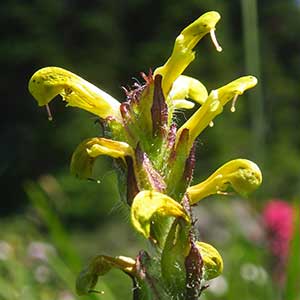Pedicularis langsdorffii
Pedicularis rainierensis
Langsdorf's lousewort, Langsdorff's lousewort
Mt. Rainier lousewort
basal 0–10, blade elliptic, 10–30 x 3–15 mm, 2-pinnatifid, margins of adjacent lobes nonoverlapping or slightly overlapping distally, serrate, surfaces glabrous;
cauline 1–4, blade elliptic, 10–40 x 2–10 mm, 1- or 2-pinnatifid, margins of adjacent lobes nonoverlapping or slightly overlapping distally, serrate, sometimes crenate, surfaces glabrous, sometimes sparsely tomentose.
basal 2–5, blade lanceolate, 40–80 x 3–20 mm, 2-pinnatifid, margins of adjacent lobes nonoverlapping or slightly overlapping distally, serrate to 2-serrate, surfaces glabrous;
cauline 2–6, blade lanceolate, 15–70 x 5–20 mm, 1- or 2-pinnatifid, margins of adjacent lobes nonoverlapping or slightly overlapping distally, serrate, surfaces glabrous.
simple, 1–6, exceeding basal leaves, each 10–50-flowered;
bracts subulate or linear, 5–25 x 1–10 mm, undivided or 1-pinnatifid, proximal margins entire, distal serrate, surfaces glabrous or sparsely tomentose to tomentose.
simple, 1–4, exceeding basal leaves, each 10–50-flowered;
bracts lanceolate or subulate to trullate, 10–15 x 1–2 mm, undivided or pinnatifid, proximal margins entire, distal serrate, surfaces glabrous or tomentose.
2.5–5 mm.
1–3.5 mm.
calyx 6–11 mm, glabrous or +/- tomentose, lobes 5, triangular, 2–5 mm, apex entire or serrate to dentate, glabrous;
corolla 17–25 mm, tube pink or lavender, 11–13 mm;
galea pink or lavender, 6–12 mm, beakless, margins entire medially, 1-toothed distally, apex strongly arching over abaxial lip;
abaxial lip pink or lavender, 5–8 mm.
calyx 7.5–11 mm, hispid to tomentose, lobes 5, linear to narrowly triangular, 4–5 mm, apex entire, glabrous or ciliate;
corolla 16–19 mm, tube light or dark yellow, 8–10 mm;
galea light or dark yellow, 8–9 mm, beakless, margins entire medially and distally, apex arching beyond abaxial lip;
abaxial lip light or dark yellow, 4–5 mm.
Pedicularis langsdorffii
Pedicularis rainierensis
Subspecies 2 (2 in the flora).
Pedicularis langsdorffii may be mistaken for P. hirsuta, P. lanata, and P. sudetica, which have similar growth forms and habitat requirements. Pedicularis langsdorffii generally has larger, pink to lavender corollas with toothed galeas that strongly arch over the abaxial lips in contrast to the smaller, toothless, pink corollas and slightly arching galeas of P. lanata. Pedicularis sudetica has up to five cauline leaves or lacks them. The straight, smaller galeas and pale pink or white corollas of P. hirsuta differentiate it from P. langsdorffii.
(Discussion copyrighted by Flora of North America; reprinted with permission.)
Pedicularis rainierensis is known from Mt. Rainier and the Crystal Mountain area. The species is easily confused with P. bracteosa var. latifolia, which often occurs in the same meadows. While the sizes and shapes of their flowers are nearly indistinguishable, P. rainierensis is a much smaller plant with leaves only about three fourths the size, proximal leaf lobes less than one fifth the size, inflorescences about one half the length, and the number of flowers greatly reduced in comparison to those of P. bracteosa var. latifolia.
(Discussion copyrighted by Flora of North America; reprinted with permission.)
1. Bracts and calyces glabrous. | subsp. langsdorffii |
1. Bracts and calyces +/- tomentose. | subsp. arctica |


